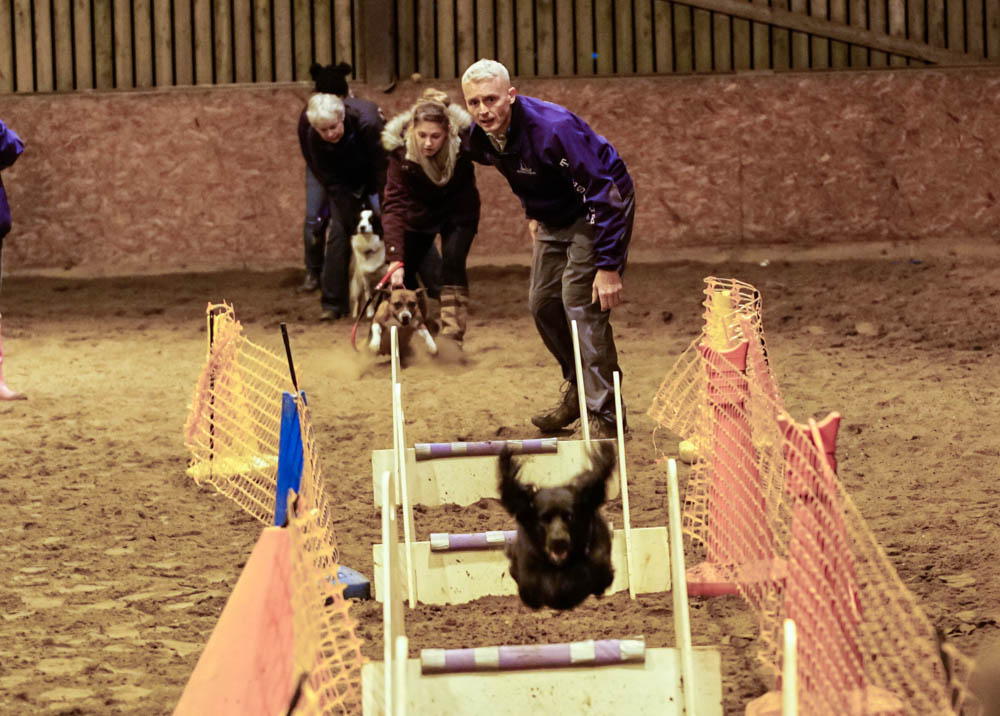Motivation to Exercise
03/04/2017
Motivation to exercise our dogs can come in many forms. We got chatting to the members of Teesdale Flyball Club to find out what keeps them coming back for more flyball exercise.
I think we’re all agreed exercise is good for us and our dogs. In fact, it is vital for our canine companions to receive physical exercise to stay in good health. Activities and games that exercise our dogs mentally as well as physically are just as important. Whilst we also know that exercise keeps their behaviour in check. A bored dog quickly becomes a badly behaved dog, displaying unwanted behaviours such as barking, aggression, anxiety and hyperactivity. I had the good fortune, a few months ago, to attend a training session of the Teesdale Flyball Club to chat to their members about winter exercise. Just as interesting though, were the varied motivations for the members to involve their dogs in this vigorous exercise.
Behaviour
Exercise that fulfils purpose or brings reward is great for building confidence in a dog of nervous disposition. Wendy’s sheep dog Izzy was a young nervous dog when she began flyball in 2016. Wendy explained that Izzy was very nervous around people and certainly Izzy did seem to retain a little wariness when I, a stranger, approached her. However, regular sessions at the flyball club had really built her confidence. She seemed comfortable around the other members and dogs that were familiar to her. When it came to the flyball course itself, Izzy was self-assured and skilled.
The sheer act of releasing tension and expending excess energy can be a great steadying influence on high energy dogs who tend towards hyperactivity. Border Collies, for example, are particularly good at high octane activities like flyball thanks to their extremely high energy levels. The breed are really designed to be working all day not kept as a family pet. However, if someone makes the decision to keep a Border Collie as a family pet, they would do well to seek out a local flyball club as a release for their dog’s energy. Sam had three dogs at the club with her: Alfie and Otis, two Border Collie/Springer Spaniel crosses, and Bea, a Border Collie. All three had boundless enthusiasm and energy, tearing up and down the flyball course repeatedly. She said that the flyball sessions were essential for her dogs, to tire them out and calm them down.
It might seem obvious, but combating restlessness, hyperactivity or other behavioural problems with structured activity is a great motivation to exercise.
Physical exercise
At the club, I witnessed dogs of all shapes and sizes flying up and down the flyball course. Lola, a big Irish Terrier, and Lexie, a small Staffordshire Bull Terrier, were two such extremes. Both with terrier instincts and high energy, they desperately need the physical exercise that flyball provides. Simply keeping a dog in shape is the prime motivation to exercise. Regulating exercise and food intake alongside each other is vital of course. This is when feeding to condition is important. Monitoring a dog’s physical condition and adjusting their food intake accordingly should prevent them from becoming under or overweight.
Mental exercise
Many dogs have instinctive skills depending on their historical uses. Dogs bred for pulling sleds love nothing more than to utilise those skills, such as in bike joring or canicross activities. Similarly, dogs bred to retrieve benefit hugely from games that exercise those natural instincts. Flyball, with its hurdles and ball retrieval, exercises a lot of natural canine skills. Willow, the Cocker Spaniel, and Alfie and Otis, with their Springer parentage, thrived on the exercise they received. It clearly brought out their best spaniel skills.
Stimulating a dog’s mental aptitude is another great motivation to exercise. It’s a great idea to introduce games into your dog’s exercise regime that reflect their natural uses and develop this intelligence, such as hunting and retrieval games for gundogs and terriers.
Any dog that is exercising sufficiently should have a diet that fills their energy reserves back up and provides all the nutrition they need to maintain peak condition. Gilbertson & Page recommend feeding to condition with one of their foods that caters to your dog’s particular needs. Owners of working dogs might like to check out the Dr John range, designed to keep them going all day long whilst protecting their hardworking bodies.
With many thanks to the members of Teesdale Flyball Club.



